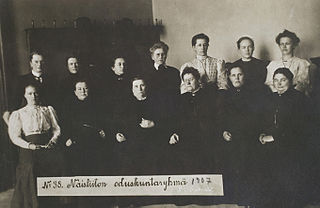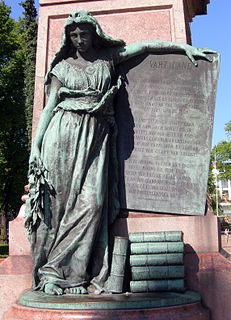
The Riksdag is the national legislature and the supreme decision-making body of Sweden. Since 1971, the Riksdag has been a unicameral legislature with 349 members, elected proportionally and serving, from 1994 onwards, on fixed four-year terms.
Elections to determine the makeup of the legislative bodies on the three levels of administrative division in the Kingdom of Sweden are held once every four years. At the highest level, these elections determine the allocation of seats in the Riksdag, the national legislative body of Sweden. Elections to the 20 county councils (landsting) and 290 municipal assemblies (kommunfullmäktige) – all using roughly the same electoral system – are held concurrently with the legislative elections on the second Sunday in September.

Women's suffrage is the right of women to vote in elections. Beginning in the late 1800s, women worked for broad-based economic and political equality and for social reforms, and sought to change voting laws in order to allow them to vote. National and international organizations formed to coordinate efforts to gain voting rights, especially the International Woman Suffrage Alliance, and also worked for equal civil rights for women.

The concept of universal suffrage, also known as general suffrage or common suffrage, consists of the right to vote of all adult citizens, regardless of property ownership, income, race, or ethnicity, subject only to minor exceptions. In its original 19th-century usage by political reformers, universal suffrage was understood to mean only universal manhood suffrage; the vote was extended to women later, during the women's suffrage movement.

The Centre Party of Finland is a centrist, liberal, agrarian political party in Finland.

Electoral reform in New Zealand has, in recent years, become a political issue as major changes have been made to both Parliamentary and local government electoral systems.

The Legislative Council, or upper house, is one of the two chambers of the Parliament of South Australia. Its central purpose is to act as a house of review for legislation passed through the lower house, the House of Assembly. It sits in Parliament House in the state capital, Adelaide.
The Young Finnish Party or Constitutional-Fennoman Party was a liberal and nationalist political party in the Grand Duchy of Finland. It began as an upper-class reformist movement during the 1870s and formed as a political party in 1894.

Elections in Kuwait are held for both the National Assembly and for the Municipality. Kuwait's constitution calls for elections to the unicameral National Assembly at a maximum interval of four years. Elections are held earlier if the Constitutional Court or Emir dissolve the parliament.

Women's suffrage – the right of women to vote – has been achieved at various times in countries throughout the world. In many nations, women's suffrage was granted before universal suffrage, so women and men from certain classes or races were still unable to vote. Some countries granted suffrage to both sexes at the same time. This timeline lists years when women's suffrage was enacted. Some countries are listed more than once, as the right was extended to more women according to age, land ownership, etc. In many cases, the first voting took place in a subsequent year.

Parliamentary elections were held in Finland on 18 March 2007. Early voting was possible from the 7–13 March. The 200 members of the Eduskunta were elected from 15 constituencies.
Parliamentary elections were held in the Grand Duchy of Finland on 1 and 2 July 1908.
Parliamentary elections were held in the Grand Duchy of Finland on 1 and 2 October 1917. The general voter turnout was higher than in previous elections. The Social Democrats lost the absolute majority that they had had in the previous two elections. In other words, the "bourgeois" (non-socialist) parties taken together now had more than half the seats.

Early general elections were held in Sweden between 10 and 26 September 1921. In the first elections held under universal suffrage, the Swedish Social Democratic Party remained the largest party, winning 93 of the 230 seats in the Second Chamber of the Riksdag. Party leader Hjalmar Branting formed his second government.
Parliamentary elections were held in Finland on 1 and 2 April 1924. Although the Social Democratic Party remained the largest in Parliament with 60 of the 200 seats, Lauri Ingman of the National Coalition Party formed a centre-right majority government in May 1924. It remained intact until the Agrarians left in November 1924. Voter turnout was 57.4%.
Parliamentary elections were held in Finland between 1 and 3 March 1919. The Social Democratic Party emerged as the largest in Parliament with 80 of the 200 seats. Voter turnout was 67.1%.

The Social Democratic Party of Finland, shortened to the Social Democrats, is a social-democratic political party in Finland. The party holds 35 seats in Finland's parliament. The party has set many fundamental policies of Finnish society during its representation in the Finnish Government. Founded in 1899, the SDP is Finland's oldest active political party. The SDP has a close relationship with Finland's largest trade union, SAK, and is a member of the Socialist International, the Party of European Socialists, and SAMAK.

Women in Finland enjoy a "high degree of equality" and "traditional courtesy" among men. In 1906, the women of Finland became the first women in Europe to be granted the right to vote. There are many women in Finland who hold prominent positions in Finnish society, in the academics, in the field of business, and in the government of Finland. An example of powerful women in Finnish politics is Tarja Halonen, who became the first female president of the country. In religion, where most of the Finnish people are members of the Evangelical Lutheran Church of Finland, women can be ordained as priests. In terms of finance, Finnish women have been described as "usually independent financially". Married women, by custom, introduces themselves by mentioning their forename first, then their maiden name, and then the surname of their husbands. The Telegraph has written:
Finnish women are much more outgoing and approachable than the men and often command three or four languages. Their position in society and business is well-respected and superior to that of women in most other cultures.






















